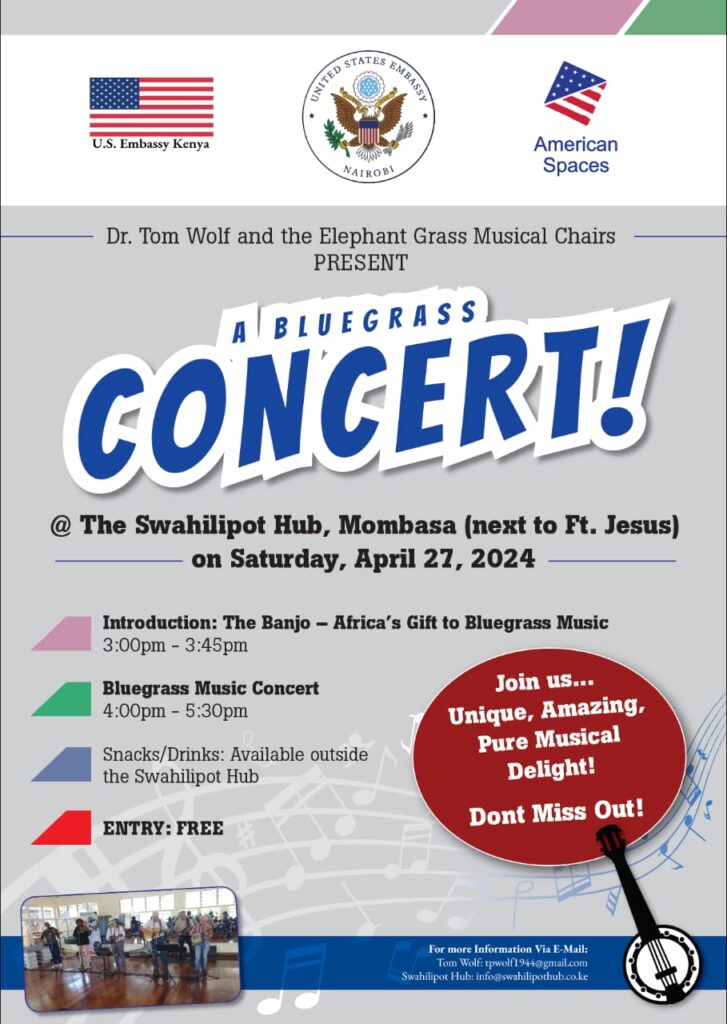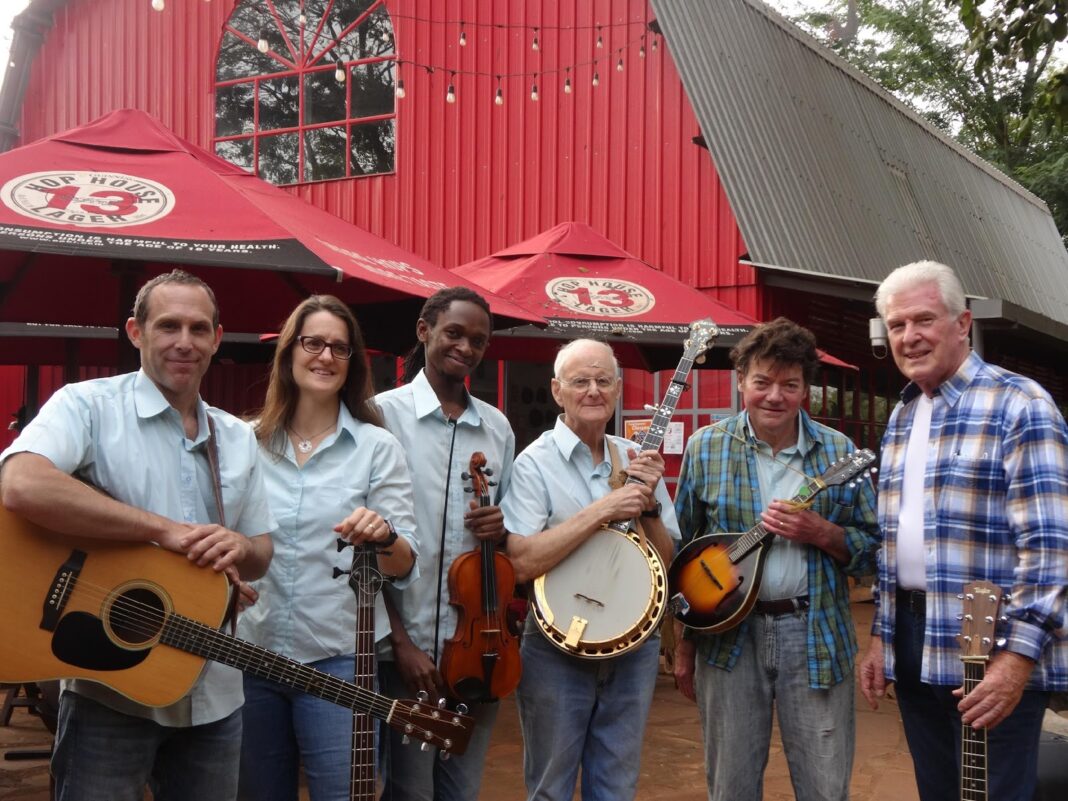What is bluegrass? For botanists, it is a species of tall grass, found especially in the middle-south area of the United States, which includes the state of Kentucky. It gets its common name from the fact that in Springtime (March-April) when the cold weather of Winter has ended and rain triggers the rapid growth of all plants, this grass – found especially in the central part of the state which is famous for its racing horses who eat it – produces a small blue flower so that if one looks at a field of it from a distance it has a light blue color, even if the grass itself is just as green as other grass.
So how did this species of grass become the name of a particular type of music? The answer begins with the fact that all fifty American states have a nickname, given in recognition of some particularly well-known aspects of each one. For example, due to the fact that the Empire State Building in New York city was for many years the tallest building in the world, New York is called the Empire State. And Kentucky, because of this very distinctive grass – and its association with its famous race horses – is called the Bluegrass state. Because of each state’s uniqueness, many people are very proud of their ‘home state’, even if they move to study, work and live in other states.
This common, state-based, pride may explain why the first leader of a band playing this type of music – Bill Monroe – called it the Bluegrass Boys, even if he was the only member in his first band of four members that he put together in 1939 who came from Kentucky. However, it was only after another ten years or so when several other bands had begun to play this same type of music (including several led by musicians who had initially been members of Monroe’s Bluegrass Boys) that radio announcers and concert promoters began to give the name “bluegrass” to all such bands, given that it had clearly come to take on a quite different form from ‘mainstream’ (i.e., more popular and thus more commercially-financially successful) country music.
Contrasts with ‘Mainstream’ Country Music
While the boundaries between these two forms of music (both having their main base of support among southern white people) are not always absolutely distinct, the main features of bluegrass that make it ‘different’ are the following:
- Electric instruments are not used, with the exception, in a small minority of bands of electric basses, as most bands use acoustic/upright ones; nor are any drums used.
- Much of the material played is instrumental rather than vocal, in two forms: (a) instrumental segments or ‘breaks’ in between the verses/choruses of songs (during which the instruments are also played, but kept at a low volume/not too close to the microphones so as not to drown out the vocals), and (b) entire pieces or ‘tunes’ without any vocals and which feature the main/standard solo instruments – banjo, fiddle, mandolin – though some bands have a guitar player with enough skills to play breaks on that instrument (and in rare occasions even a bass player can play a break, usually when the other instruments are kept silent so it can be more easily heard).
- While not all band members are singers – though there must be at least three in order to have three-part harmony choruses on some songs – all must play some instrument. (The most common non-singer in bluegrass bands are the fiddlers, since it’s not possible to sing with the instrument tucked under one’s chin, though a fiddler may stop playing and hold the instrument far enough away from his mouth/face to do so). At the same time, having more singers is a bonus as this allows for a greater variety of vocal combinations. In any case, the songs sung as solos all the way through are few; most involve one or two harmonies, at least on the choruses, though a certain proportion are song in two or even three-part harmony throughout.
- There is far less emphasis on a particular band member or ‘star’, even if some bands have very well known ‘lead’ (melody) singers, who are often band leaders and most commonly guitarists, especially in terms of talking in between songs and tunes by introducing each one and perhaps adding some other comments about the band’s activities and so on.
- Despite the origin of many of its most common instrumental numbers that were played at dances, it is not performed for this purpose; rather it is an ‘audience’ music, where (at indoor concerts or outdoor festivals – that are often three more days’ long and with a larger number of bands, each playing perhaps 45 mins. one after the other, aside from rest periods during lunch and dinner times – where people are sitting in chairs and listening, to both the instrumentals and songs, but with a lot of informal ‘jam sessions’ taking place especially during meal-time and at night after the concerts are over (and where it is not uncommon for some members of the performing bands who are not already on the road driving to their next festival to join in).
- While some bands are known for writing/creating their own new songs and even instrumentals, most performance-content is from elsewhere: (a) from traditional sources, i.e., songs and tunes usually of no clear origin but that have been played and passed down through several generations many before BG as a specific genre even existed, or from other early or contemporary bands and not all BG; there is much less emphasis on creating new ‘hits’.
- Most band programs include a substantial portion or religious or ‘gospel’ songs in their repertoire for performances and recordings.
- A significant proportion (even if a minority) of those who attend performances and even just buy recordings also ‘pick’ and ‘sing’, at whatever level of proficiency; indeed, many are in local bands that may perform in some nearby hotels or restaurants or other establishments, or even just ‘living room’ bands that never perform in public.
- Many fans, especially those who also play, have a great interest in the particular instruments that members of professional bands have and play, especially with regard to guitars, banjos and mandolins, some of which (especially those made before WWII) are very expensive, however infrequently they actually are found for sale. For example, a mandolin made by a certain company and signed by a certain craftsman in the early 1920s can cost more than Shs. 30m/-.
Reasons for its Limited Popularity
More generally, bluegrass is not nearly as popular as ‘mainstream’ country music, if by “popular” we mean some combination of: (1) sales of recordings, (2) concert ticket sales, and (3) audience-size ratings by radio and TV stations and possibly also visits to bands’ websites/purchase of products displayed on such sites. While it isn’t possible to measure its precise level of popularity, its limited scale is based on the following:
- The rural, ‘traditional’ origins of the music and its continued concentration of support among less well-educated and usually poorer whites in the SE gives it an appearance or ‘packaging’ that the vast majority of urban people in the NE and far west – where far more people live – find alien or unpleasant, especially since most people in its core areas are conservative and usually more religious.
- Although many of the tunes (instrumental numbers) that entered bluegrass from earlier string-band music were mainly played for dancing (by couples, often in groups of 8 – called “square dancing”), these days its performances are hardly accompanied by dancing (though in outdoor settings a few people sometimes get out of the chairs and start solo dancing if there’s sufficient space of that nearby). By contrast, much of mainstream popular music is used for dancing (in indoor clubs) on a regular basis.
- For various reasons, many of themes of bluegrass songs are sad: about death, lost love, poverty, bad luck, and so on – not topics that many people find pleasant to listen to, but which are extremely appealing to certain personality types: those that might be considered more thoughtful and open to difficult emotional considerations.
Bill Monroe’s first band in 1939 had five instruments: upright/acoustic bass, guitar, violin, mandolin and accordion, though this latter instrument was soon replaced by the 5-string banjo. Taking these five instruments as the standard combination in most bluegrass bands, the nature and role of each can be described as follows:
- Bass (acoustic or electric): The bass has four (usually nylon or animal-gut) strings, and moving from the lowest to the highest pitch they are: E, A, D and G, and these are ‘plucked’ with (most usually, for right-handed people) the right index finger while the index and ring fingers of the left hand are used for pressing the strings down. Note that as with the violin, the bass has no frets (thin metal bars across the neck of the instrument which allow for very precise noting when the finger is placed below the fret – that is, on the ‘bottom’ side, closest to the sound holes and farthest from the peg-head at the top where the strings are attached to the tuning pegs. The main role of the bass to provide on-beat rhythm and tempo – that is, keeping all the other instruments in ‘sync’ with each other – though, as mentioned above, skilled bass players may also take solo breaks.
- Guitar: The guitar has six metal strings, tuned (from top/the thickest string to bottom/the thinnest string) being E, A, D, G, B and E (which is standard ‘Spanish’ guitar tuning). It is played with a flat, plastic pick (or ‘plectrum’), almost always in a way that any of the four heaviest strings are struck to provide an on-beat while the thinner strings are then struck (usually more lightly) on the off-beat. The heavier strings are also used to play ‘runs’, in which the pick moves from one of the heavier bass strings to the next heaviest string (or strings) without touching the lighter strings.
- Violin/fiddle: These two terms refer to the same instrument, which like the bass is made entirely of wood and has four strings with the same notes, though for the fiddle it is the thickest string that it is tuned to G and the thinnest tuned to E. Fiddles perform several roles. For instrumentals they are used to play the melody and any variations thereof, many of a rather spontaneous nature, depending upon the skill and imagination of the fiddler. The same is true for instrumental breaks during songs, while fiddlers may also provide ‘fills’ during vocals, especially when there is a gap whenever the voices trail off (and when no other solo instrument is doing this). Finally, the bow can be lightly tapped on one or more strings to provide off-beat rhythm when this is needed.
- Mandolin: This eight-string instrument, also like the bass, guitar and fiddle made entirely of wood (again, aside from the metal tuners but also usually with a metal tail-piece over the metal plate where the strings are attached at the bottom) is tuned exactly like a violin/fiddle, though with two strings for each note (aside from a few instrumentals that employ a special ‘split-string’ tuning). Unlike the fiddle, however, it has frets so as to eliminate the possible imprecision that applies to the fiddle, and is played (like a guitar) with a flat-pick (though often one a bit smaller in size), and its use is more evenly divided between melody for ‘break’s and ‘fills’ on the one hand, and off-beat rhythm, on the other. For the latter, most players chords using four fingers so that immediately after the chord is sounded they can be at least partly pulled off to dampen/silence the sound so that it does not linger and thus compete/interfere with the following on-beat. Additionally, like the fiddle, the mandolin can add brief ‘fills’ during vocal gaps.
- Banjo: This instrument gives bluegrass perhaps its most distinctive sound. Like its West African antecedents, the sound is made when the circular head (previously a dried animal skin, but these days humidity-resistant plastic) resonates in response to the plucking of strings by the thumb and first two fingers that are covered with picks (usually plastic for the former and metal for the latter). This resonation is amplified by a similarly circular plate or cover on the back of the instrument that is almost made of a particular hard/dense type of wood so as to maximize volume. The plastic drum-head is affixed with a circular wooden frame which is, in turn, affixed to a circular metal casing by means of more than one dozen metal brackets, while the wooden plate (or “resonator”) on the back is held in place by four metal screws. These metal parts invariably make banjos much heavier than all the other instruments described above (aside from the bass, given its size). The banjo also differs from all the other instruments in that it is given an ‘open’ tuning, meaning that all of its five strings are tuned to produce a full chord (usually G), without any strings being pressed down/fretted. Like the guitar,mandolin and fiddle, the banjo’s strings are arranged with the thicker, heavier ones at the top, in the following order: D, G, B and D. However, there is also a fifth string above all of these four string which is attached about half-way up the neck, thus giving it a much higher pitch, and which is (usually) tuned to G (when all the other strings are tuned to this key). In terms of its contribution to the band’s sound, the banjo’s role is similar to the mandolin’s, in that it can be used both to play solos (usually close to the melody) by the plucking of individual strings and to provide rhythm by fretting the four full-length strings and plucking them all at once on the off-beat. In addition, it can also be used like the fiddle and mandolin to play brief ‘fills’ during gaps in the vocals or even ‘behind’ them (that is, keeping the instrument some distance from any microphone).
- Mandolin and fiddle: The banjo’s strings are arranged with the thicker, heavier ones at the top, in the following order: D, G, B and D. However, there is also a fifth string above all of these four string which is attached about half-way up the neck, thus giving it a much higher pitch, and which is (usually) tuned to G (when all the other strings are tuned to this key). In terms of its contribution to the band’s sound, the banjo’s role is similar to the mandolin’s, in that it can be used both to play solos (usually close to the melody) by the plucking of individual strings and to provide rhythm by fretting the four full-length strings and plucking them all at once on the off-beat. In addition, it can also be used like the fiddle and mandolin to play brief ‘fills’ during gaps in the vocals or even ‘behind’ them (that is, keeping the instrument some distance from any microphone).
Vocals
In general, most bluegrass songs are sung at the highest pitch possible, keeping in mind that since most songs also involve a higher, tenor, part on chorus, the person with the highest vocal range must be able to ‘hit’ (or reach) the highest notes in that part. This practice of singing at as high a pitch as possible also applies to those songs for which the melody is the highest part on choruses.
Another main characteristic of bluegrass music is that there is little division between the musicians and vocalists in a band. That is, while not all band members must necessarily also sing, everyone who sings must also play some instrument, though just who sings on which songs depends on several factors, especially:
- Their vocal range (i.e., what are the highest or lowest notes they can sing)
- How well their voices blend with each other
- Whether the song itself is a solo, even on the chorus, and if not, how many voices are used either throughout the song or just on the chorus
- What vocal arrangement is used on the song, especially whether the melody is ‘on top’ singing the highest part, or more commonly, is ‘sandwiched’ in the middle between a tenor part above and a baritone part underneath.
In our band, based on who is present for any particular performance, several people may sing solos and/or the melody part in choruses.
The African-Bluegrass Connection
Africa has influenced the emergence and development of bluegrass in three main ways. First, is the presence of the banjo which is derived from various string-gourd instruments from West Africa that were both brought over to the “New World’ by some slaves in the 17th and 18th centuries or made there later by them and their descendants. However, it only began to be played by whites towards the end of the 18th century. Second, is the influence of (first) slave and (later) post-slavery African-American singing styles, especially those related to blues music. Third, is the ‘transfer’ or ‘movement’ of particular tunes and songs from African-American to (first) southern mountain (white) music and later into bluegrass after it emerged. In addition, some much more recent African-American songs have been ‘translated’ into bluegrass (as has been done with some songs from white rock music). Thus, even if there are no African-American bluegrass bands, bluegrass music could not have appeared without this ‘African’ contribution.
This ‘African-American’ element is perhaps captured in Bill Monroe’s (frequent, on-stage) summary of how he “put bluegrass together”, which he said was based on the following four elements;
- The bagpipe music of Scotland (where his ancestors came from)
- The fiddle music of Ireland (that was preserved and developed by American settlers and their descendants, especially in Appalachia)
- The chorus singing in the (especially Baptist) churches (also in the southeastern American states)
- The blues guitar playing/singing of Arnold Shultz, and ‘black’ farmer laborer and itinerant musician who worked on farm near Monroe’s home in west-central Kentucky and who also played fiddle in Monroe’s Uncle Pendleton Vandever’s local dance band (whose other members were all white, ‘Uncle Pen’ being the leader and main fiddler, and about whom Monroe wrote one his most well-known songs, ‘Uncle Pen’, the chorus of which is:
Late in the evening, about sundown
High on a hill and above the town
Uncle Pen played the fiddle, Lord, how it would ring
You could hear it talk, you could hear it sing.
The Band
Gwendolyn Anding: Acoustic/Electric Bass, Vocals
Gwendolyn, an American originally from the state of Wisconsin, is an international high school music educator in Nairobi where she (along with her husband) has been teaching music for six years. She is a ‘brass & strings’ person, performing on the French horn in both the Nairobi Orchestra and the Nairobi Music Society. She plays upright/acoustic and electric bass and mandolin in several other Nairobi bands as well.
Mike Craig: Guitar, Vocals
Mike was born in Northern Ireland but has lived/worked in Kenya since 1976. Starting with piano lessons when he was only seven, Mike has also been in many vocal groups. In addition to the Elephant Grass Musical Chairs, he has been a long-time member of Nairobi’s well-established Hootenanny folk band, and plays in an Irish music group as well that he started. In addition to the guitar, he also plays the bouzouki in several of these other groups.
Scott Mwangi: Fiddle
Scott, who often works as a scuba diver/marine biology researcher, has been playing violin since 2009 during his high school days in Nairobi. He played both in bands (including that of Elvis, Kenya’s best known country music performer) and solo (at weddings, parties, and other events) for which he plays a variety of violin music. He only joined the Elephant Grass Musical Chairs in late 2023 and had not heard of bluegrass before then, so is still ‘getting to know’ what this type of fiddling is all about, since it’s quite different from the sort of music that he’s played before. But he has made notable progress, playing both melody and harmony parts.
Stephanie Mwaura: Fiddle
Stephanie was born in Kiambu County. With both of her parents being music teachers, she was exposed, and learned, a number of instruments from an early age. Over recent years, however, she has concentrated most on the violin. She was introduced to the Elephant Grass Musical Chairs band in 2021 when a former/part-time band member visited her home. Although she (like Oscar) had never heard of bluegrass before, she (like Oscar) picks up tunes by ear very quickly. When both she and Oscar are present, she plays the melody and Oscar plays a harmony part above hers, making for a very unique ‘twin-fiddle’ sound.
Tom MacWilliams (‘T-Mac’): Mandolin (also guitar, electric bass)
T-Mac was born 1959 in Kansas and came to Kenya more than 40 years ago. He lives on his own plot in Kajiado County, near Corner Baridi. He mostly plays mandolin in the band, but can also play guitar, electric bass, banjo and some fiddle and kalimba. He also contributes to vocals, either on lead or baritone (on choruses)
Tom Wolf: banjo (also mandolin, guitar)
Tom first came to Kenya as a Peace Corps Volunteer in the 1960s and has lived here most of his life. He is the band organizer/leader, and the only member to have played in a bluegrass band before, starting when he was in college (as a guitar player and lead vocalist). He also played/led bands in Sweden, England and (a short-lived one) in Tanzania. He began listening to bluegrass on the radio when very young, and was fortunate to have attended concerts by nearly all the ‘first generation’ bands, including several by Bill Monroe and the Bluegrass Boys. He also contributes to vocals, either on lead, baritone and (sometimes) tenor.
Several other ‘Musical Chairs’ are also available to fill in when needed. The most active ones are: Brad David (guitar, vocals), Paul Mueller (electric bass, vocals), and Yaniv Gelman (acoustic bass).
Altogether, the band offers a mix of a wide variety of instrumental and vocal combinations, and of note, the band’s two fiddlers are (as far as is known) the first two people from any African country (in this case, Kenya, of course) to play in any bluegrass band, anywhere.
Band Repertoire
In deciding what to learn and practice, these are the factors we take into account:
- What material band members know/are aware of. This comes mainly from recordings or from other people members have played with or watched.
- What suits the different lead/melody voices, and the various harmony combinations in the band.
- What gives a variety in terms of tempo (speed).
- What puts the emphasis on different instruments.
- What is within the range of the members’ instrumental ability (‘chops’).
- What gives a variety in terms of song-topics:
- Happy
- Sad
- Ballad/stories
- Gospel (religious)
- Standard bluegrass ‘traditional’ songs from well-known singers/bands
- Audience ‘favorites’, based on what are known as the most popular/widely-known songs and tunes
- What the band needs to keep playing to work on their singing and playing skills (‘vocals’ and ‘chops’).
Though what the band ends up playing on any particular event is a combination of the above with input from anyone in the band who wants to have a say.

PS: The above was input from Dr. Tom Wolf on Bluegrass music and their band. Dr. Tom Wolf and the Elephant Grass Musical Chairs will be performing at Swahilipot Hub, Mombasa, on Saturday April 27th. A great opportunity to experience Bluegrass music. I for one am excited to attend the concert and experience something different. Karibuni!
SUPPORT: We are a non-funded entity kept alive solely by our readers’ thirst for the undocumented and not adequately documented aspects of our past. The logistics of getting these stories can sometimes be a challenge. We would appreciate your support. To support Pwani Tribune’s history and culture research plus content creation…M-PESA till number: 8627478 Contact: +254726860693



